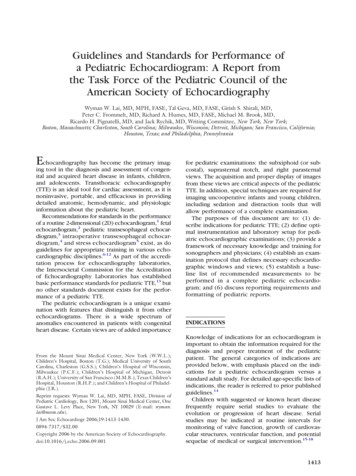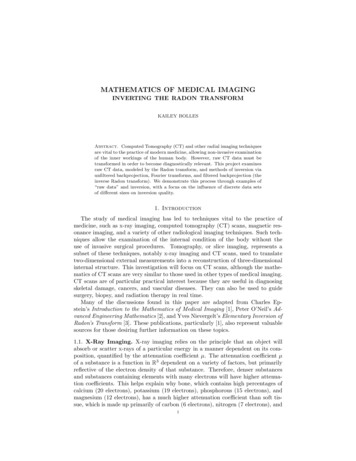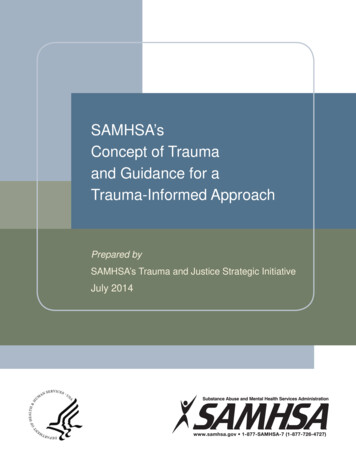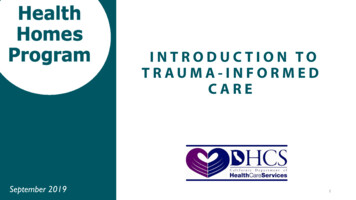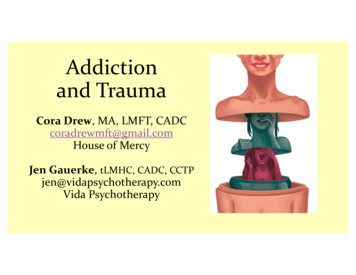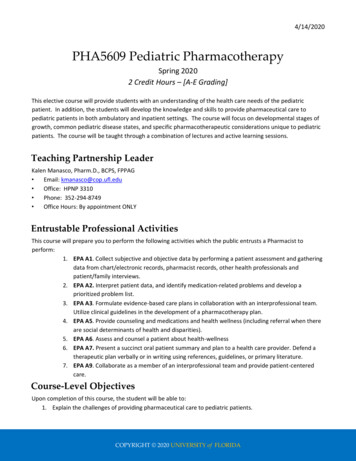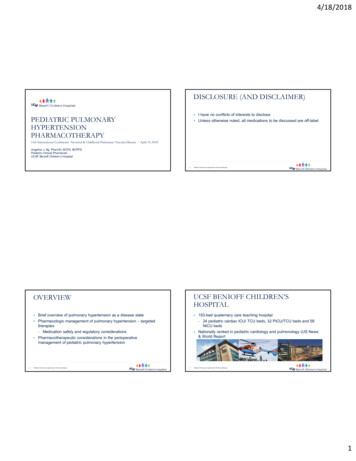
Transcription
Imaging Guidelines inPediatric TraumaJon Ryckman, MD, FACSMedical Director, Pediatric TraumaSanford Children’s Hospital
I have no financialconflicts of interest todisclose
Pediatric TraumaConsiderations Mortality from trauma surpasses deathsfrom all other illnesses combined Typical mechanisms of injury based onage and stage of development Multisystem injury is the rule rather thanthe exception
Pediatric TraumaConsiderations Ionizing radiation does pose a real risk ofmalignancy in children
Objectives Identify the risk of ionizing radiation inchildren Discuss the utility of advanced imaging inpediatric trauma Propose guidelines for imaging in pediatrictrauma patients Identify resources for imaging guidelines
Trauma inChildrenLeading cause ofdeath and disability
Pediatric Trauma Data On average, 9000-13000 children die each year fromunintentional injury Death rates highest from motor vehicle crashes,particularly in the upper Plains Native American death rate highest among all races Over 9 million children present to ER each year forinjury More than 16% of admissions for unintentional injuryresult in permanent disability
Impact of Pediatric Trauma
Injury Prevention
Mechanism of Injury Automobile occupant Pedestrian struck Bicycle Fall from height ATV accidents Non-Accidental trauma
Mechanism of Injury Pedestrian vs. Auto Slow speed Soft tissue contusions Lower extremity fractures Fast speed Polytrauma Head, chest, abdomen, lower extremity fractures
Mechanism of Injury Automobile Accident Unrestrained Multiple organ systems Head, neck, abdomen Restrained Seatbelt complex
Mechanism of Injury Bicycle Without Helmet Head, face, spine, upper extremityfractures Handle bar Liver, spleen, pancreas, duodenum
Mechanism of Injury Fall from Height Low level Soft tissue contusions, upper extremityfracture High level Polytrauma Head, face, spine, abdomen, long-bonefracture
Assessment of the Pediatric TraumaPatient
ABC’s Airway Breathing Circulation Disability Exposure/Environment
Adjuncts Lab tests “Trauma panel” may be excessive Needles hurt! Xrays CXR Pelvis
Additional Imaging Based on clinical suspicion FAST CT scans C-spine series Extremity x-rays
The Trouble with Radiation CT scanning carries a necessary exposure toionizing radiation Head CT 200 plain films Chest CT 150 chest x-rays Abdominal CT 250 flat plates Full body CT same dose of radiation asreceived by survivors 1.5 miles away fromHiroshima atomic explosion
Is there really a risk?
Risk of Malignancy Risk of developing fatal malignancysecondary to CT scan is 1:1000 Risk inversely proportional to age Risk may be site specific as well Neck CT exposes thyroid gland, lymphnodes, salivary glands to high dose ofradiation
Risk of Malignancy 2001 Study on risk of FATAL malignancydue to CT scan 0.18% Abdominal CT 0.07% Head CT 600,000 CTs performed yearly, 500 ofthose patients may die from the CT
Risk of Malignancy Multiple studies on risk from CT scan 3x Increased risk of leukemia and brain tumors (2012) Highest risk in younger patients and girls, Abd/Pelvisand Spine CT (2013) In girls, one solid cancer may result: 300-390 Abd/Pelvis 330-480 Chest 270-800 Spine
What do we do?
Imaging Guidelines ATLS: Do not delaytransfer to center ofdefinitive care byperforming imaging 66% of patientsmeeting transfer criteriareceive scans At least 25% of thosescans are repeated
Is physical exam enough? Seat belt sign Abdominal bruising Abdominal wound Abdominal tenderness
FAST Data concerning FAST exam in childrennot conclusive When combined with physical exam, maybe equivalent to CT for predicting intraabdominal injury User-dependent
Blunt Abdominal Trauma Failure of non-operativetherapy for solid organinjury in children is 3% Those that fail, usuallyfail within the first 6hours after injury
Abdominal CT scans Not always necessary Should be done atdefinitive care center Must be done with IVcontrast
TraumaticBrain Injury Greater than 50% ofall deaths resultingfrom blunt traumaare due to braininjury
Brain Injury Goal of therapy is to prevent secondaryinjury Ischemia Hypoxemia Hypotension Cerebral edema Increased intracranial pressure
Head Injury Over 85% of brain injuries are mild and not lifethreatening Less than 50% of patients with TBI on head CTpresent with GCS 14-15 Among children presenting with GCS 15 afterblunt head injury, prevalence of TBI is 0-7%,surgical intervention in 1% Isolated loss of consciousness has almost norisk of significant traumatic brain injury
Head Injury PECARN criteria -traumaalgorithm
Imaging for Blunt Head Injury
Child Abuse Highest morbidity and mortality for headinjury seen in setting of abuse 40% mortality Nonfatal outcomes worse for abusedchild than for similar injuries in nonabused
Risk of C-spine injuries Very rare: 1-3% of all pediatric traumapatients Only half with vertebral injuries haveneurological deficits SCIWORA may occur in 2/3 with spinalinjury
Cervical Spine Imaging Altered Mental StatusFocal deficitsNeck painTorticollisSubstantial torso injuryPredisposing condition (connective tissue disorders, etc)High risk MVC (rollover, ejection, etc.)Diving Absence of any of these variables less than 2%chance of injury Application of this rule could potentially reduceionizing radiation and/or immobilization by 25%
Conclusion Pediatric Trauma is a leading cause ofmorbidity and mortality Rapid, appropriate interventions are lifesaving and can prevent morbidity Advanced imaging in pediatric trauma isnot without risk and should only be usedwhen the benefit outweighs the risk
Imaging should never delay transfer todefinitive care If advanced imaging is considered,please consult with definitive care center
Head CT should be done WITHOUTcontrast Chest or abdominal CT scans must bedone WITH contrast
Our children are our onlyhope for the future, but weare their only hope for theirpresent and their future.
Any Questions?
Over 85% of brain injuries are mild and not life threatening Less than 50% of patients with TBI on head CT present with GCS 14-15 Among children presenting with GCS 15 after blunt head injury, prevalence of TBI is 0-7%, surgical intervention in 1% Isolated loss of consciousness has almost no

